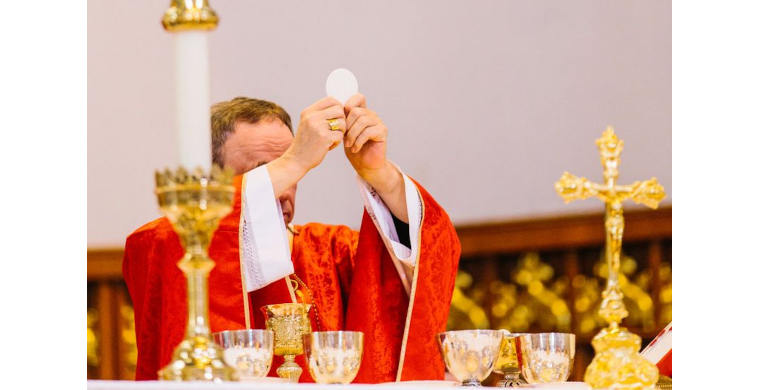TRANSUBSTANTIATION?
By Chuck Collins
https://www.anglicanism.info/blog
November 8, 2022
Transubstantiation became the official doctrine of the Roman Catholic Church at the Fourth Lateran Council that began, November 11, 1215. The Council of Trent in 1551 went on to confirm the doctrine of transubstantiation as Catholic dogma, and today's Catechism of the Catholic Church plainly states: "there takes place a change of the whole substance of the bread into the substance of the body of Christ our Lord and of the whole substance of the wine into the substance of his blood" (1376).
Anglicans emphatically reject this teaching (Thirty-nine Articles of Religion, XXVIII), but it is the greatest curiosity that some still hold a functionally Roman view - that the elements of Holy Communion, at a moment in the liturgy (marked by an epiclesis, fraction, and the raising of the bread for public gazing) change from being bread and wine into the actual body and blood of our Lord. A minute earlier it was simple bread, but now with the words and actions of a sacrificing priest it is the Creator of the universe lifted high for everyone to see, and everyone who consumes it eats Christ's body whether they believe it or not (manducatio indignorum).
Why is it important that we get this right? Because the other biblical core matters that were recovered at the time of the English Reformation (Holy Scripture as our authority, the priesthood of all believers, and the central doctrine of justification by grace through faith alone) hinges on how we view "real presence" in the sacrament. The sixteenth century English reformers knew this and they were willing to die for their understanding of "real presence" in the sacrament, as many did.
Historically and confessionally Anglicans teach that sacraments are "effectual signs of grace" (not mere symbols or memorials; they are much more than badges or tokens), and that "real presence" is Christ's spiritual presence that is experienced in the hearts of believers when the grace of the sacrament is received by faith. Since his bodily Ascension, Jesus remains spiritually present everywhere ("I am with you always"), of course, but he remains corporeally in heaven where he reigns in authority with the Father until the day he will return ("I will return in the same way"). Jesus is not bodily present "in" the bread and wine as if he rushes down from heaven to enter into our mouths and then into our stomachs. It is not "Jesus" sitting on the altar waiting to be gazed upon and worshipped. No! It's far more wonderful than that! He is powerfully and spiritually offered in the sacrament when the grace of the sacrament is received by faith in the hearts of God's people, uniting us to Christ - "...be filled with thy grace and heavenly benediction, and made one body with him, that he may dwell in us, and we in him." This is the union or spiritual "commingling" of which Cyril of Alexandria wrote which deeply influenced Thomas Cranmer.
Archbishop Thomas Cranmer, the architect of Anglican liturgy, wrote extensively about this in 1550 "A Defense of the True and Catholike Doctrine of the Sacrament of the Body and Blood of our Saviour Christ." He devoted the third of four books to the question of real presence, citing the church fathers at length. Cranmer wrote: "They [Roman Catholics] say, that Christ is received in the mouth and entereth in with the bread and wine: we say, that he is received in the heart, and entereth in by faith" (Book III, Ch. II). "Cranmer's focus was not a change in, or even instrumental use of, the bread and wine, but rather the transformation of the recipients, who by the power of the Spirit were linked afresh to the saving efficacy of Christ's Incarnation and Passion" (Ashley Null "Cranmer and the Sacraments").
Richard Hooker, a second-generation Reformation writer, was more irenic and nuanced, but his eucharistic doctrine was the same as Cranmer's. He taught the centrality of faith, whereby Christ is dynamically present in the liturgical action rather than statically in the consecrated bread and wine, in a moment of consecration. "The real presence of Christ's most blessed body and blood is not therefore to be sought for in the sacrament, but in the worthy receiver of the sacrament...only in the very heart and soul of him which receiveth" (Hooker's The Laws of Ecclesiastical Polity, V.67.6).
Obviously, many Anglicans have rushed to other understandings of "real presence" than those found in Anglican formularies and the Anglican fathers. Many of them are essentially transubstantiation; without the elaborate Thomistic explanation of changing substance and unchanging appearance, they chalk up their version to "mystery."
But even they will admit that our sacramental theology is originally rooted in a unified understanding of "real presence" that gives rich and powerful meaning to the glory of God's effectual grace in the hearts of believers. To say this doesn't matter, or to dismiss it as mystery as if it doesn't deserve our concerted attention, demeans the core reformational doctrines that define what it means to be Anglican.
END














